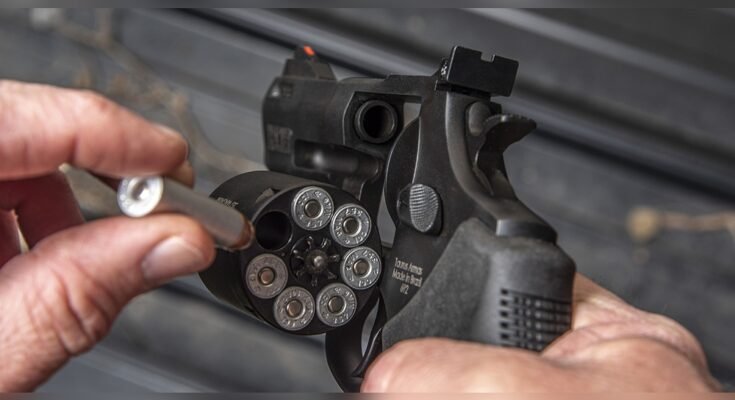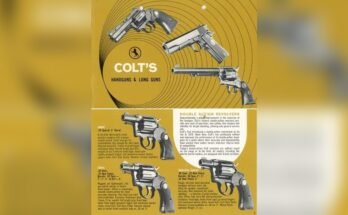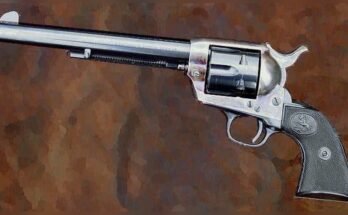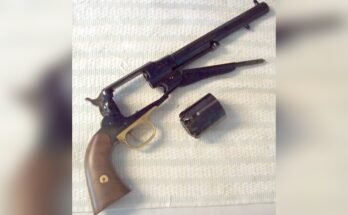If you own a swing-out cylinder revolver or are thinking about getting one, you might wonder if you need special tools to maintain or repair it. You want to keep your firearm in top shape, but the idea of complicated equipment can be intimidating.
What if the tools you need are expensive or hard to find? You’ll discover exactly what tools are necessary for your swing-out cylinder revolver. By the end, you’ll feel confident handling your revolver without extra hassle or guesswork. Keep reading to unlock the simple truth about maintaining your firearm safely and effectively.
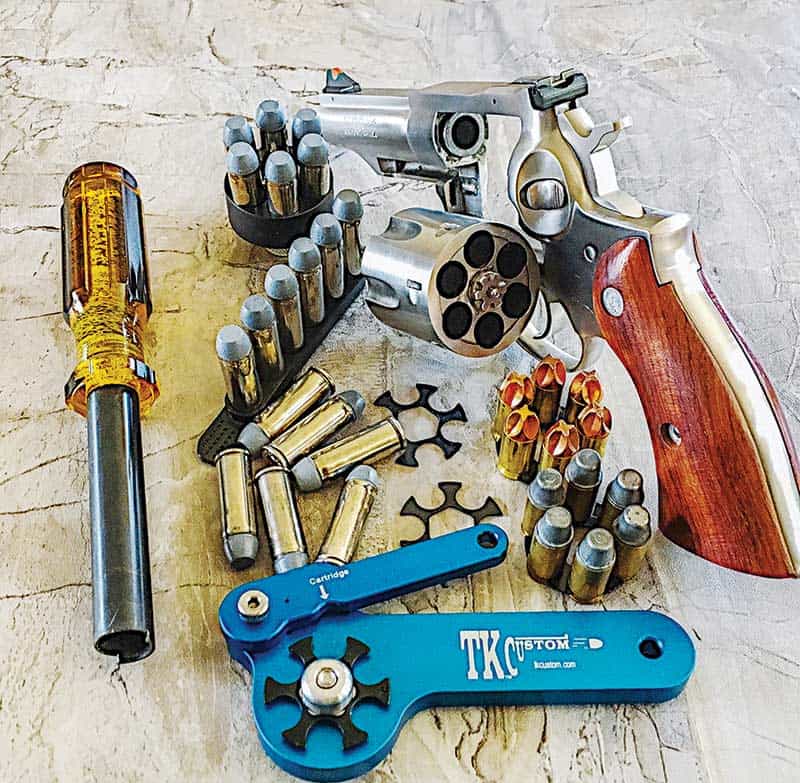
Swing-out Cylinder Revolvers Basics
Swing-out cylinder revolvers are popular firearms known for their ease of use. The cylinder swings out to the side, allowing quick access to the chambers. This design helps with faster reloading compared to older revolvers with fixed cylinders. Understanding the basics of swing-out cylinder revolvers is important for users and enthusiasts alike.
Key Features
Swing-out cylinder revolvers have a cylinder that swings out from the frame. This feature allows the shooter to load and unload cartridges easily. Most models have a latch that releases the cylinder. The cylinder holds multiple rounds, usually five or six. The design improves speed and convenience during use. These revolvers also typically have solid frames and simple controls.
Common Models
Many manufacturers produce swing-out cylinder revolvers. Popular models include the Smith & Wesson Model 686 and the Ruger GP100. Colt’s Detective Special is another well-known example. These revolvers vary in size and caliber. They are used for self-defense, sport shooting, and law enforcement. Each model offers reliable performance and straightforward maintenance.
Routine Maintenance Needs
Routine maintenance is key to keeping swing-out cylinder revolvers in good shape. These revolvers have parts that move and work together, so regular care helps them last longer. You do not need special tools for most tasks. Basic cleaning and lubrication keep the gun reliable and safe to use.
Cleaning Procedures
Start by opening the cylinder to access the chambers. Use a soft brush to remove powder residue and dirt. Run a cleaning patch soaked with solvent through each barrel. Wipe the frame and cylinder with a cloth. Avoid soaking the gun in liquid. Let all parts dry fully before reassembly. Clean after every use to stop rust and buildup.
Lubrication Tips
Apply a small drop of gun oil to the moving parts. Focus on the cylinder pivot and the ejector rod. Too much oil can attract dust and dirt. Wipe off any extra oil with a clean cloth. Lubricate after cleaning or firing the revolver. Proper lubrication prevents wear and keeps the action smooth.
Tools For Cylinder Removal
Removing the cylinder from a swing-out cylinder revolver requires certain tools. These tools help you take apart the revolver safely and correctly. Using the right tools protects the revolver’s parts and keeps them working well. Knowing which tools to use makes the process easier and faster.
Standard Tools Used
A small screwdriver is often needed to remove screws holding the cylinder in place. A punch tool helps push out pins without damaging the metal. A soft hammer, like a nylon or rubber one, taps pins gently. A cleaning cloth keeps parts clean and free of dirt during removal.
Purpose Of Each Tool
The screwdriver loosens or tightens screws carefully. The punch tool removes pins that hold the cylinder assembly. The soft hammer provides gentle force without scratching the revolver. The cleaning cloth prevents dirt or oil from entering small parts. Each tool plays an important role in safe cylinder removal.

Specialized Tools And Their Roles
Specialized tools play a key role in maintaining swing-out cylinder revolvers. These tools help with cleaning, repair, and safe handling of the firearm. Using the right tool prevents damage and ensures smooth operation. Understanding which tools are needed helps owners care for their revolvers properly.
Some tasks need special tools to access parts safely. These tools make it easier to remove or adjust components without harm. For anyone working on their revolver, knowing the right tool to use saves time and effort.
When Special Tools Are Needed
Special tools are required during detailed maintenance or repair. Tasks like removing the cylinder, adjusting timing, or replacing springs often need them. Simple cleaning may only need basic brushes and cloths. But parts inside the revolver need precise handling. Using incorrect tools can cause scratches or misalignment. Special tools allow careful disassembly and reassembly.
These tools also help during upgrades or part replacements. Some components fit tightly or have small pins. Special tools help to avoid damaging these parts. For example, timing adjustments need tools that hold parts steady. This ensures the revolver works safely and reliably.
Examples Of Specialized Tools
A common tool is the cylinder pin removal tool. It helps slide out the pin that holds the cylinder. Another is the hand press tool, used to remove or install the hand that turns the cylinder. Timing tools hold the cylinder in place for accurate adjustments.
Spring compressors help remove or install the mainspring safely. Small punches and pin punches drive out pins without damage. Screwdrivers designed for gun screws prevent stripping heads. Cleaning kits often include brushes shaped for cylinder chambers. Each tool has a specific purpose that keeps the revolver in top condition.
Diy Vs Professional Servicing
Choosing between DIY repairs and professional servicing for swing-out cylinder revolvers is important. These firearms have unique mechanisms. Proper care ensures safety and performance. Knowing the differences helps you make the best choice for your revolver’s maintenance.
Risks Of Diy Repairs
DIY repairs can lead to mistakes. Swing-out cylinder revolvers need precise handling. Using wrong tools can damage parts or misalign the cylinder. This may cause the gun to jam or become unsafe. Lack of experience increases the chance of errors. Fixing these problems often costs more time and money. Incorrect repairs can also void the firearm’s warranty.
Benefits Of Expert Assistance
Professional gunsmiths have the right tools and skills. They understand the complex design of swing-out cylinders. Experts perform repairs that keep the revolver reliable and safe. They can spot hidden problems early. Professionals provide a warranty on their work. This gives peace of mind and protects your investment. Proper servicing extends the life of your revolver and keeps it working smoothly.

Troubleshooting Common Issues
Troubleshooting common issues with swing-out cylinder revolvers helps keep them working well. These revolvers are reliable but can face small problems over time. Fixing these early stops bigger issues later.
Cylinder Alignment Problems
Cylinder alignment is key for safe shooting. Misalignment can cause the gun to jam or misfire. Check if the cylinder locks firmly in place. If it moves too much, the locking mechanism may need cleaning or light lubrication. Dirt or debris often causes misalignment. Use a soft brush to clean the locking parts gently. Avoid heavy oils that attract dust. Tighten any loose screws carefully, but do not overtighten. If problems continue, inspect the cylinder stop for wear or damage.
Ejector Rod Maintenance
The ejector rod pushes out spent cartridges. If it sticks or feels rough, cleaning is needed. Remove dirt and old grease with a cloth. Apply a small amount of light oil to the rod. Move it back and forth to spread the oil evenly. Avoid using too much oil, which causes buildup. Check for bends or dents in the rod, as these affect function. Replace the rod if it is damaged. Proper maintenance keeps the ejector rod smooth and reliable.
Frequently Asked Questions
Do Swing-out Cylinder Revolvers Need Special Tools?
Swing-out cylinder revolvers usually don’t require special tools for basic maintenance. Most parts are accessible by hand or standard screwdrivers. However, detailed repairs might need specific tools to avoid damage and ensure proper function.
How Do You Remove The Cylinder On These Revolvers?
To remove the cylinder, unlock the cylinder latch usually located on the frame. Swing the cylinder out gently. For full removal, a basic punch or screwdriver may be needed, depending on the model.
Can I Clean A Swing-out Cylinder Revolver Without Tools?
Yes, you can clean it with minimal tools like a cloth and brush. However, detailed cleaning often needs a bore brush, cleaning rod, and solvent for best results.
Are Special Tools Required For Cylinder Timing Adjustments?
Yes, cylinder timing adjustments often require specific tools. These tools help align the cylinder precisely with the barrel to ensure safe and accurate firing.
Conclusion
Swing-out cylinder revolvers usually need some special tools. These tools help keep the parts safe and work right. Using the right tool makes cleaning and fixing easier and safer. Without them, you might damage the gun or hurt yourself. Simple tools like screwdrivers might not fit well.
So, investing in proper tools is wise for any owner. Taking care of your revolver keeps it working longer and better. Always follow instructions and use the right gear. Safe handling matters most for a good shooting experience.
